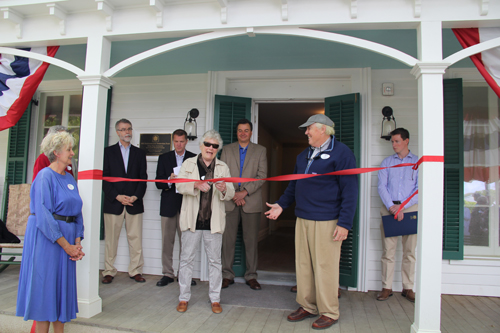Photos: Village House restoration complete, open to all

After decades of fundraising, planning and restoration, the Oysterponds Historical Society unveiled its newly refurbished and now preserved museum Saturday. The 1798 Village House on Village Lane in Orient opened to the public for the first time in five years.
The society, with the help of its members, the community and a $228,000 Environmental Protection Fund grant, raised nearly $700,000 to fully restore the house.
The house, acquired by the society in 1944, resembles that of a boardinghouse, once operated by Gilson Vail and his wife Roxanna in the mid-1800s.
It is the only boardinghouse of that era on Long Island, said Clare Adams, executive director of the society.
“There were once hundreds of these types of inns on Long Island,” she said. “This is the only one left that was preserved.”
County Legislator Al Krupski, deputy regional director of state parks Brian Foley, and town Supervisor Scott Russell spoke at the unveiling, commenting on the work of members and volunteers who helped ensure the staple in Orient history was preserved.
Proclamations were also presented from the governor’s office and from state Assemblyman Anthony Palumbo.
Fredrica Wachsberger, former president of the society who began working on the project over a decade ago, said society members preserved as much of the house as possible, utilizing wooden floorboards corner beams, and wallpaper to capture its original appeal.
The home, having been built on a single course of stones, had been rotting from the ground up due to moisture, Ms. Wachsberger said, explaing that the work involved excavating a crawl space beneath the structure to repair the masonry foundation.
A new roof was installed. Electrical wiring and heat were added for the first time ever, including a climate control system to help keep it preserved.
The history of the home was first mentioned in the diaries of Augustus Griffin, the author of the first published history of Southold in August 1798.
Known as the Village House, it had also been used as a tavern, a polling station and a stop on a stagecoach route before it was transformed into a boardinghouse in the mid-1800s, when the area first attracted tourists, according to the society.
While the first floor will have the feel of the boardinghouse, the second floor is being used as a more modern museum.
The upstairs, where six guestrooms were located, now boasts six different exhibits, together displaying “Oysterponds at Home, at Play and in Wartime.,” designed by Bill McNaught, museum curator.








